

How to Prepare Actionable PhD Research Plan Template
“Where PhD is highly uncertain, an actionable PhD research plan would give you calculative and tentative outcomes. And even more, the ready-to-use template makes things even better. Let’s take a close look at the research plan + template.”
Before moving forward, it’s important to understand the process and steps in research . Then only you can make an actionable plan for your PhD research. It’s literally like driving without breaks— that you don’t want.
In a broader sense, when you plan something, it shows two things: first, you are actually serious about the work you are planning and second, you are expecting some outcomes. And by a plan, you are heading towards it.
I know, plans may not work 100% all the time, but they may create a definite path to achieve at least 80% success in the work you are doing. This is also true for a PhD— in which you would constantly try to justify a single sentence– your research title.
So– Yes, the research process is undetermined and so the results too! but here is the catch and perhaps answer why you have to have a research plan. In this article, I will explain the importance of a research plan, an actionable research plan and a ready-to-use template for you.
How to prepare an actionable research plan?
Importance of phd research plan , wrapping up.
An actionable research plan is what you have to rely upon. So it should be perfect and approved. how can you prepare your own? Let’s see.
Understand the steps in the research and closely follow them.
Define the objectives and scope of your study.
Define each goal of your study– For example, sample collection, wet lab work, standardization, experimentation, data collection and interpretation, etc.
Enlist what types of problems you may face for each goal– For example, transportation for sample collection, Lack of facilities in wet lab work, etc.
Find a solution for each problem you have enlisted– For example, appoint an expert for sample collection and transport samples in a cold chain. If your lab doesn’t have some instruments or chemicals, priorly contact other labs and ask them for help.
Draw a rough road map for your work— the route using which you will achieve your research goals. Also, make a backup. What if the route or process you selected would not work? Check out this drawing to understand my point.
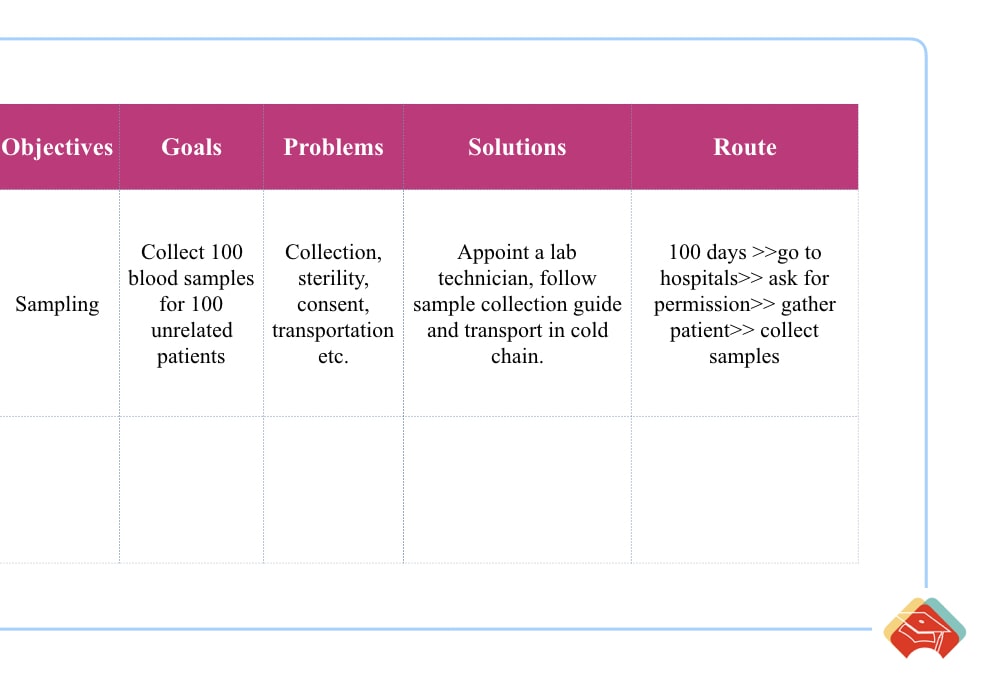
Now prepare a timeline— in how much time a particular goal should be achieved. For example, 6 Months for sampling (Including, ethical approval, approval from sampling authority, consent, preparation and arrangement for utilities).
Another is sample collection— 3 Months which isn’t covered in the 6 months of sampling objective, like this. Take a look at the drawing here.
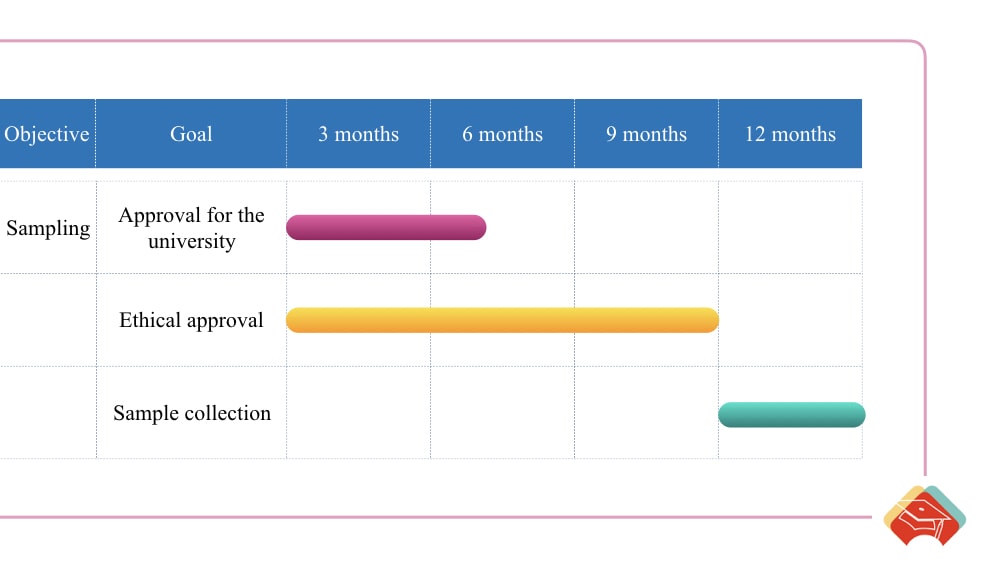
Note: This timeline must match with your GANTT chart for PhD timeline because you are making an actionable plan.
Now your plan is reading. You are now aware of each objective, goal and problem. Some you probably solved, and some you can manage later. This you can print and stitch in your logbook or can save on your desktop.
Take a look at the advantages, and why it’s important to prepare an action plan.
Related article: How to Prepare a PhD Research Plan/Schedule?
Let’s start with two real-world examples first.
One of my friends, after sample collection and initiating the testing, found out that she also has to perform hormone assays for samples. The samples she collected are 3 months old— not possible to assess quantitative analysis.
Another colleague after sample collection– when he started working in the wet lab, came to know that one important instrument is not there in their lab. His guide is very serious about the goal that they have to do it anyhow.
He sent applications to various universities and research centers to work on that particular instrument. From approval to real testing, it tools all almost 8 months including, approval, training, transportation, etc.
Wasted much time!
- An actionable research plan saves your time— which is a crucial factor in PhD.
- It makes you aware of the pros and cons of your study.
- It makes you aware of the problems and limitations of the research you conduct.
- It gives you a broad roadmap to achieve your PhD in “some” tentative time.
- It gives you the flexibility to achieve goals and enjoy your time at the same time.
- You can make real-time monitoring of how your research is going and how much work is left.
- It makes you aware of what should be your next move and the preparations you required.
However, keep in mind that once you prepare a plan, review it from your guide, take their advice, enlist major objectives and techniques you would use for the study and stick to it.
Before preparing that, read the literature regarding your topic and understand the way in which your research should be headed.
Check out our fully customizable, ready-to-use and actionable research plan template.
Download a research plan template
These things look a bit old school but it works, really works well. Most students don’t do it and end up messing things and at last, came to know that they wasted their time. At least, the research plan will tell you where you are stuck (probably) and you can find a solution.
We know how hard it is to predict the future of PhD or how it would go. But let me tell you, with an actionable plan, many do well. And you can too. Take your doctorate seriously from day one. And do accordingly.
Remember your goal should be to complete your degree in time.

Dr. Tushar Chauhan is a Scientist, Blogger and Scientific-writer. He has completed PhD in Genetics. Dr. Chauhan is a PhD coach and tutor.
Share this:

- Share on Facebook
- Share on Twitter
- Share on Pinterest
- Share on Linkedin
- Share via Email
About The Author

Dr Tushar Chauhan
Related posts.

A Definite Research Process for PhD- What Students Should Know?

What are Research- Aim, Objectives, Tasks/Goals? [Our System]
Leave a comment cancel reply.
Your email address will not be published. Required fields are marked *
Save my name, email, and website in this browser for the next time I comment.
Notify me of follow-up comments by email.
Notify me of new posts by email.
/images/cornell/logo35pt_cornell_white.svg" alt="phd study plan template"> Cornell University --> Graduate School
Create your plan.

Cornell Resources to Help You Create Your Plan
Self-assessments.
All graduate students are encouraged to meet with a Cornell career advisor to take an assessment to understand their personality, interests, values, and career goals. Postdocs may discuss their interests, values, and career goals with Christine Holmes ( [email protected] ), director of the Office of Postdoctoral Studies.
- Find assessments available to all graduate students .
- Find free online assessments available to all students and postdocs .
- Ask yourself reflection questions to identify your career goals, interests, and skills.
External Resources
Individual development plan (idp).
The IDP is an excellent tool for self-assessment and developing goals for yourself during your academic years and beyond. Although you can create your IDP by yourself, graduate students and postdocs often find that co-developing their IDP with their faculty mentor is a good way to ensure there is awareness and support of their career plans.
IDPs for humanities and social science fields:
- Imagine Ph.D. (all fields in the humanities and social sciences)
- University of Wisconsin-Madison (all fields)
- American Psychological Association
- University of Southern California Postdoctoral Office (for postdocs in all fields but could be used for graduate students)
IDPs for science, technology, engineering, and math (STEM) fields:
- ScienceCareers myIDP (all STEM fields)
- American Chemical Society (for chemical scientists)
- Stanford University Biosciences (for bioscience fields)
Books, References
- Do What You Are: Discover the Perfect Career For You Through the Secrets of Personality Type by Paul Tieger (available in 103 Barnes Hall and Cornell Library System)
- So What Are You Going To Do With That? A Guide to Career-Changing for M.A.s and Ph.D.s by Susan Basalla and Maggie Debelius (available in 103 Barnes Hall and Cornell Library System)
- Effective Phrases for Performance Appraisals: A Guide to Successful Evaluations by James Neal, Jr. (available in Cornell Library System)

Computer Science Plan of Study Templates

How to plan, structure and write every chapter in your PhD
In this collection, we’ll walk you through each chapter of your thesis. You’ll learn what goes where and how it fits together.

The PhD Discussion Chapter: What It Is & How To Write It
Your PhD discussion chapter is your thesis's intellectual epicenter. Think of it as the scholarly equivalent of a courtroom closing argument, where you summarise the evidence and make your case. Perhaps that’s why it’s so tricky - the skills you need in your...

Everything you wanted to know about structuring your PhD but were too afraid to ask
Understanding how to structure your PhD is tough. It helps to break it down into four distinct sections. In this guide, we explain how.

How to find the thread that runs through your PhD thesis
You probably worry about finding the thread that runs through the PhD thesis. In this guide we walk you through what’s required.

How to edit a PhD thesis (without going mad)
Your thesis takes a lot of time to research, ideate, and write. Here’s how to properly edit a PhD thesis such that you impress your examiners and achieve even greater success.

The 9 most effective ways to achieve PhD success
Writing a PhD is physically, intellectually and emotionally daunting. You may spend each day doubting yourself, not sure if you’re making the right choices and unsure whether you’ve got what it takes. During my life, I’ve helped thousands of PhD students like...

How To Structure A PhD Thesis
Struggling to understand what goes where? Let us walk you through a non-nonsense guide that’ll teach you how to structure a PhD thesis.

The difference between empirical and discussion chapters (and how to write them)
There is a very important distinction that needs to be made between the empirical and discussion sections/chapters. It is a common misconception that the empirical chapters are the place for your analysis. Often this confuses the reader.

Five tips to improve your PhD thesis
Regardless of what stage of the writing process you are at, there are five overarching tips you need to keep in mind if you want to improve your PhD thesis.

What are you doing and how are you doing it? Articulating your aims and objectives.
How long does it take the person reading your thesis to understand what you’re doing and how you’re doing it? If the answer is anything other than ’in the the opening lines of the thesis’, keep reading.

Learn how to write a PhD proposal that will stand out from the rest
When stripped down to its basic components, the PhD proposal explains the what and the why of your research. What it will be about and why it will be important.

Easily understand how to write a PhD thesis introduction
Get the introduction right and the rest of your dissertation will follow. Mess it up and you’ll be struggling to catch up. The introduction is the place to factually recount what it is you will be discussing in the thesis. Learn more in this detailed guide.

Last impressions count – writing your PhD thesis conclusion
The conclusion is the last thing your examiner will read before they write their viva report. You need to make sure it stands out.

What is a dissertation abstract and how do I write one for my PhD?
Don’t underestimate how hard it is to write a PhD thesis abstract. When I wrote mine I though it’d be straightforward. Far from it. It’s tricky. You have to condense hundred of pages and years of work into a few hundred words.

Russian (dolls) to the rescue – how to structure an argument in your PhD
At the core of the PhD are arguments. Lots of them. Some more important and some very specific. When you understand how to structure an argument, your thesis reads clearly and logically. If you don’t the reader ends up confused and your thesis suffers.

Drowning in a sea of authors – How to be critical in a PhD literature review.
Don’t get lost in a sea of authors when you write your PhD literature review. Instead be critical. In this guide we explain how.

Wrestling an elephant into a cupboard: how to write a PhD literature review in nine easy steps
When I was writing my PhD I hated the literature review. I was scared of it. I thought it would be impossible to grapple. So much so that it used to keep me up at night. Now I know how easy it can be and I’m sharing my top tips with you today.

A Template To Help You Structure Your PhD’s Theoretical Framework Chapter
In this guide, I explain how to use the theory framework template. The focus is on the practical things to consider when you’re working with the template and how you can give your theory framework the rockstar treatment.

How To Structure A PhD With Our PhD Writing Template
Our PhD Writing Template allows you to visualise your PhD on one page. Here we explain how to fill it in and how it can help you structure each chapter.

Eureka! When I learnt how to write a theoretical framework
The theoretical framework is so important, but so misunderstood. Here we explain it is in simple terms: as a toolbox.
Explore Other PhD Knowledge Base Collections
Eight collections of free resources to help you along the phd journey.

Mastering your theory and literature review chapters

How to structure and write every chapter of the PhD

How to stay motivated and productive

Techniques to improve your writing and fluency

Advice on maintaining good mental health

Resources designed for non-native English speakers

Explore our back-catalogue of motivational advice
Each week we send out a short, motivational email to over 4,000 students. Here you can sign up and access the archive.

A free one-page PhD structure template
UI SENS PhD Study Plan
A doctoral study plan template for the School of Engineering and Natural Sciences at the University of Iceland.
A repo for issues and updates is here: https://github.com/HaoZeke/ui_sens_phd_plan

Get in touch
Have you checked our knowledge base ?
Message sent! Our team will review it and reply by email.
Email:
How to develop an awesome PhD timeline step-by-step
A successful PhD journey begins with a solid plan that includes a PhD timeline . A thought-through and well-designed PhD timeline requires some time but can be accomplished in a few simple steps.
Why a clear PhD research timeline matters
Step 1: decide what to include in your phd timeline, step 2: discuss your provisional phd timeline with your supervisor/s, step 3: design your phd timeline, step 4: regularly update your phd timeline.
Doing a PhD means committing to a challenging project that spans several years. Therefore, it is no surprise that doing a PhD can feel quite overwhelming. How do you even begin to tackle such a huge project?
A PhD timeline breaks down the daunting task of doing a PhD into an actionable plan with tasks and milestones along the way.
Even if not everything will go as planned (which is normal and no problem!), a PhD timeline can give PhD students peace of mind. A good plan, worked out in a PhD timeline, helps them to structure their time, communicate their goals and work toward specific targets.
Some PhD students are required to create a PhD timeline as part of their programme. Yet, even if PhD students are not required to do so, it is highly recommended to create a PhD timeline!
PhD timelines should be as diverse as PhD research projects: What you decide to include in your timeline should fit to your situation, goals and your programmes’ requirements.
Common elements included in a PhD timeline are the following:
- Data collection : How, when and where are you collecting your research data?
- Fieldwork : Is your data collection spread out or are you spending several weeks doing fieldwork? If so, when is this scheduled and how can you avoid overlaps with other requirements, such as coursework?
- Experiments : Are you running experiments for your PhD research? If so, when? And how long do you estimate this will take you?
- Data analysis : Once you have your data, be it quantitative or qualitative data, when and how do you analyse it? How much time do you block for this task?
- Writing plan : When are you writing down your results? How can you break down writing into different parts, for instance, writing goals per chapter or article?
- Publications : Publication requirements differ from PhD programme to programme. Even if you write your PhD as a monograph (instead of a selection of articles) , you should try to publish something during your PhD. When would you have an opportunity to do so, and how much time does it require?
- Conferences : Every PhD student should present at a conference during their PhD trajectory. Which conferences are you interested in? When do they take place, and when would you have findings to share at a conference?
- Coursework : What are your PhD programme’s coursework requirements? What courses are you interested in, and when are they offered?
- Other activities : Are there any other activities that are crucial for your PhD project? Think, for instance, about an extensive dissemination campaign, collaboration with external partners, internships, online activities etcetera.
Make a draft plan, including dates and times. Then move to Step 2: Discussing it with your supervisor/s!
Proactively creating your PhD timeline is a good step as a PhD student. However, you should share your thoughts and ideas with your PhD supervisor/s and get their input.
If possible, set up a meeting with your supervisor/s that is entirely dedicated to your PhD timeline. During this meeting, you can share what you created so far.
Then, you should discuss the following questions:
- Is there anything missing in the PhD timeline?
- Is the PhD timeline realistic?
- Should anything be removed from the PhD timeline to prioritise other tasks?
- Does the PhD timeline meet all the formal requirements to graduate within the designated amount of time?
- Is there institutional support and sufficient financial resources for activities such as fieldwork, conference attendance, etcetera?
Make sure to take notes during the meeting, as you will need the answers to these questions to edit your provisional PhD timeline.
Not only will this discussion help you to finalise your PhD timeline. It will also help you to get clarity on your supervisor/s’ expectations!
You may also like: Planning your PhD research: A 3-year PhD timeline example
Following the input of your supervisor/s, your PhD timeline will reach a more final stage. Now it is time to think about designing your PhD timeline:
A well-designed PhD timeline is not just pretty for the eyes, but it makes it much easier to have a good overview of all plans and milestones ahead.
Yet, it would be wrong to argue that there is a one-size-fits all solution to designing a perfect PhD timeline.
Maybe you are a very visual person and would prefer your timeline to illustrate a broad overview of the upcoming years. Maybe you are encouraged by checking things off your to-do list. In that case, a more detailed PhD timeline with many different tasks and milestones may be more suitable for you.
A common way to design PhD timelines is via Gantt charts. If you want to learn more about Gantt charts for your PhD timeline, check out my post on how to design Gantt charts in Microsoft Excel, Power Point and Word.
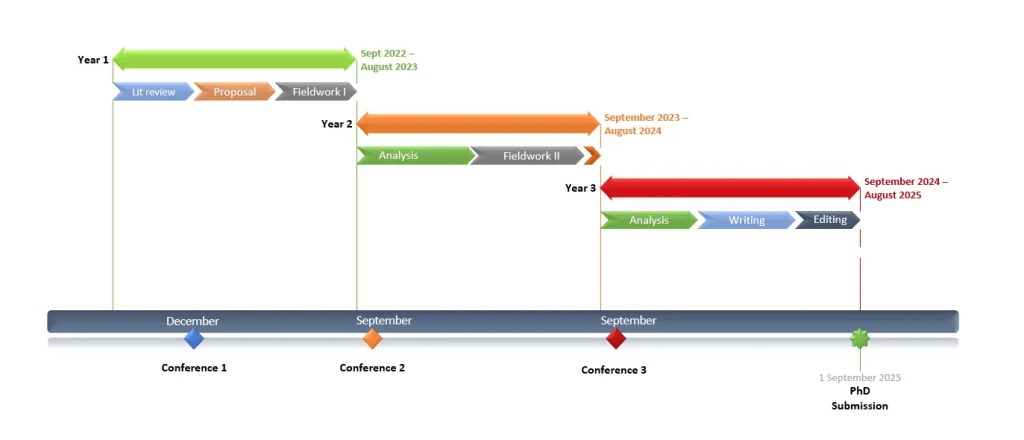
A PhD timeline is there to keep you on track and to showcase the milestones that you reached in your journey so far. However, while it is good to have a solid plan, the future is impossible to predict.
Your PhD timeline should be a living document or chart. Update it regularly!
For instance, a conference may be cancelled. You may have a period of sick leave. An experiment may not work out as planned. Or writing a paper takes longer than expected.
Successful PhD students remain flexible and don’t panic as soon as something does not work out as planned.
So, use your PhD timeline to regularly reflect on your progress and your current situation. Update your PhD timeline when needed, to prioritise tasks and set more concrete and achievable goals for the upcoming months.
Master Academia
Get new content delivered directly to your inbox.
Subscribe and receive Master Academia's quarterly newsletter.
Left your dissertation too late? Ways to take action now
The best email signatures for graduate students (with examples), related articles.

Revise and resubmit: Sample peer review comments and examples

10 tips on how to use reference management software smartly and efficiently

How to organize and structure academic panel discussions

17 strong academic phrases to write your literature review (+ real examples)
- PRO Courses Guides New Tech Help Pro Expert Videos About wikiHow Pro Upgrade Sign In
- EDIT Edit this Article
- EXPLORE Tech Help Pro About Us Random Article Quizzes Request a New Article Community Dashboard This Or That Game Popular Categories Arts and Entertainment Artwork Books Movies Computers and Electronics Computers Phone Skills Technology Hacks Health Men's Health Mental Health Women's Health Relationships Dating Love Relationship Issues Hobbies and Crafts Crafts Drawing Games Education & Communication Communication Skills Personal Development Studying Personal Care and Style Fashion Hair Care Personal Hygiene Youth Personal Care School Stuff Dating All Categories Arts and Entertainment Finance and Business Home and Garden Relationship Quizzes Cars & Other Vehicles Food and Entertaining Personal Care and Style Sports and Fitness Computers and Electronics Health Pets and Animals Travel Education & Communication Hobbies and Crafts Philosophy and Religion Work World Family Life Holidays and Traditions Relationships Youth
- Browse Articles
- Learn Something New
- Quizzes Hot
- This Or That Game
- Train Your Brain
- Explore More
- Support wikiHow
- About wikiHow
- Log in / Sign up
- Education and Communications
- College University and Postgraduate
- Applying for Tertiary Education
- Scholarships
How to Write a Study Plan for a Scholarship
Last Updated: October 25, 2023 Fact Checked
This article was co-authored by Alexander Ruiz, M.Ed. . Alexander Ruiz is an Educational Consultant and the Educational Director of Link Educational Institute, a tutoring business based in Claremont, California that provides customizable educational plans, subject and test prep tutoring, and college application consulting. With over a decade and a half of experience in the education industry, Alexander coaches students to increase their self-awareness and emotional intelligence while achieving skills and the goal of achieving skills and higher education. He holds a BA in Psychology from Florida International University and an MA in Education from Georgia Southern University. This article has been fact-checked, ensuring the accuracy of any cited facts and confirming the authority of its sources. This article has been viewed 243,227 times.
If you are asked to write a study plan for a scholarship, you may not know where to begin. Basically, a study plan describes what you'll be studying and why. One common scholarship committee that asks for study plans is the China Scholarship Council (CSC). Start by establishing your main educational goals, and then talk about how you plan to achieve them. Conclude your study plan, and spend time refining your writing.
What to Write About

- For instance, maybe your main goals for studying in China are to gain a bachelor's degree in business and learn Chinese because it's becoming a global language. You could write, "My main two educational objectives are to gain a bachelor's degree in business and to learn to speak Chinese. Chinese is becoming a global language, so I feel it's necessary to learn it."

- For instance, you might write, "I was born in the United States, but my grandparents on both sides are Chinese. I chose this business program because I want to connect with my heritage, improve my Chinese, and eventually, help establish better relations between China and the U.S. by improving trade relations."

- For example, you might say, "As a PhD candidate, I plan to conduct research on how ancient tradition and ritual influence contemporary Chinese culture, which will include a literature review and extensive interviews with historians and a small sampling of the Chinese population."

- It can help to draw a conceptual model. Start with the antecedents (the causes) and the mediators (the processes that change the antecedents). Finish with the outcomes. Draw lines between them to help you see which variables are more central to your problem.
- Consider asking peers or professors to look at your research proposal. They may be able to help you narrow.

- For instance, you might say, "One of my long-term goals is to open an import business from China to the United States, and learning about business in China will be essential to making my endeavors a success."
Explaining Your Plans

- For instance, if you plan on doing a PhD where you'll need participants, discuss how you'll find people for your study. You might say, "I plan to put out an ad to gain participants for a focus group, as well as contact historians by phone and email for interviews."

- For example, you might write, "I anticipate the language barrier will be an issue at first. However, I plan to work hard early on to learn the language, and I am already taking intensive classes now."

- To help you choose, do a thorough literature review. Look at the research that has been done in the area you plan to study. Note the primary methods used to do the research and the pros and cons of each. Choose a method based on what you think will work best for your research. [6] X Trustworthy Source American Psychological Association Leading scientific and professional organization of licensed psychologists Go to source

- For instance, you might use simple random sampling or systematic sampling when the whole population is similar based on the variables for your study. On the other hand, a stratified random sample is often used when you have people who are different from each other based on your variables.
Concluding and Refining Your Writing

- For example, you might write, "Thank you for considering me for this scholarship. If I receive this award, I can focus solely on my studies. I will work hard to implement my goals of learning Chinese and gaining a business degree at a Chinese university, and your trust in me will not be wasted."

- You don't need to write as if you're talking to a child. However, you should write so someone outside of your discipline can easily understand your plan.

- The space for the study plan on the CSC application is only a couple of lines. However, the application suggests you attach more paper as needed.

Scholarship Study Plan Template


Community Q&A
You Might Also Like

- ↑ https://www.ecpi.edu/blog/how-to-set-educational-goals-and-meet-them
- ↑ https://bangalorestudy.com/blog/factors-to-consider-while-choosing-a-school
- ↑ Alexander Ruiz, M.Ed.. Educational Consultant. Expert Interview. 18 June 2020.
- ↑ http://www.apa.org/gradpsych/2005/03/methods.aspx
- ↑ https://www.collegedata.com/resources/money-matters/10-ways-to-stand-out-when-applying-for-scholarships
- ↑ http://www.natco1.org/research/files/SamplingStrategies.pdf
About This Article

If you’re unsure how to go about writing a study plan for a scholarship, focus on explaining your educational goals and discussing how you’ll achieve them. Begin by briefly stating what you want to study and why. For example, you might say you want to study business management in China so you can learn Chinese, because it will soon be a global language. Then, provide some personalized reasons as to why you chose the school you want to go to, such as research interests or long-term goals. After laying out your goals, show the scholarship committee how you’ll achieve them. If you’ll be carrying out research, for instance, write about how you’ll find participants for your study. You should also try to mention possible obstacles and how you’ll overcome them, since the committee will be impressed to see you’re thinking ahead. For tips on how to proofread your study plan before sending it off, keep reading! Did this summary help you? Yes No
- Send fan mail to authors
Reader Success Stories
Lusine Ohanyan
Mar 4, 2019
Did this article help you?

May 30, 2020
Apr 3, 2019

Featured Articles

Trending Articles

Watch Articles

- Terms of Use
- Privacy Policy
- Do Not Sell or Share My Info
- Not Selling Info
wikiHow Tech Help Pro:
Level up your tech skills and stay ahead of the curve

Research Voyage
Research Tips and Infromation
Ph.D. Proposal Presentation Template
A Ph.D. proposal presentation template is a pre-designed set of slides that can be used as a starting point for creating a presentation for your Ph.D. proposal Registration. It includes a series of suggested slides, which you can customize to your specific needs. This template can be used by Ph.D. candidates from various fields who are preparing for their Ph.D. registration.
Slide 1: Title Slide
- Title of the work
- Candidate’s name and affiliation
- Supervisor’s name and affiliation
Slide 2: Introduction
- Briefly introduce the topic
- Explain why the topic is important and relevant
- Provide a brief overview of what the presentation will cover
Slide 3: Literature Review
- Summarize the key findings of relevant literature
- Identify gaps and limitations in the existing research
- Explain how your work will contribute to filling these gaps
Slide 4: Motivation and Research Problem
- Explain the motivation behind your work
- Clearly state the research problem you are addressing
Slide 5: Research Question and Objectives
- State your research question
- Clearly articulate your research objectives
Slide 6: Study Design and Methods
- Explain your study design and why you chose it
- Describe your data collection methods and measures
Slide 7: Predicted Outcomes
- Present your predicted outcomes if everything goes according to plan
- Explain how these outcomes will contribute to the field
Slide 8: Resources
- Identify the resources you will need to complete your work
- Explain how you will obtain these resources
Slide 9: Societal Impact
- Describe the potential societal impact of your work
- Explain how your work will benefit society
Slide 10: Gantt Chart
- Present a Gantt chart representing the timetable of the activities planned
- Explain how you will manage your time to complete your work on schedule
Slide 11: Potential Challenges
- Identify potential challenges you may encounter during your research
- Explain how you plan to address these challenges
Slide 12: Conclusion
- Summarize the key points of your presentation
- Conclude by emphasizing the significance of your work and its potential impact
Slide 13: Questions
- Encourage the audience to ask questions
- Thank the audience for their attention
Remember to keep your presentation simple, well-structured, and effective. Use clear and concise language, and make sure your presentation is visually engaging. Good luck with your PhD proposal presentation!
- Title of the work: “A Comparative Study of Deep Learning Techniques for Image Recognition in Medical Imaging”
- Candidate’s name and affiliation: Sarah Johnson, Department of Computer Science, University of ABC
- Supervisor’s name and affiliation: Dr. Robert Lee, Department of Computer Science, University of ABC
In this slide, you have to include the title of your work, your name and affiliation as the PhD candidate, and your supervisor’s name and affiliation. The title should be concise and descriptive, conveying the essence of your research.
- Briefly introduce the topic: Deep Learning Techniques for Image Recognition in Medical Imaging
- Explain why the topic is important and relevant: Accurate and efficient image recognition in medical imaging is crucial for diagnosis, treatment planning, and monitoring of patient progress. However, the current state-of-the-art algorithms still have limitations in handling the complexities of medical images, such as noise, variation in size and shape, and variation in imaging protocols.
- Provide a brief overview of what the presentation will cover: In this presentation, I will introduce my proposed research on a comparative study of deep learning techniques for image recognition in medical imaging. I will briefly cover the literature review, the research problem and goals, the study design, and the expected outcomes of the research.
In this slide, you have to provide an introduction to your research topic, explaining its importance and relevance in the field. The introduction should set the context for your research and explain why it matters.
- Summarize the key findings of relevant literature: Previous research has shown that deep learning techniques, such as convolutional neural networks (CNNs) and recurrent neural networks (RNNs), have achieved state-of-the-art results in various image recognition tasks, including medical image recognition. However, the performance of these techniques can be affected by factors such as the size and complexity of the dataset, the selection of hyperparameters, and the choice of architecture.
- Identify gaps and limitations in the existing research: While previous studies have compared the performance of different deep learning techniques for image recognition in general, there is a lack of research that compares and evaluates the performance of these techniques specifically in medical imaging. Additionally, there is a need for research that investigates the effectiveness of transfer learning, data augmentation, and other techniques for improving the performance of deep learning models in medical image recognition tasks.
- Explain how your work will contribute to filling these gaps: The proposed research aims to contribute to filling these gaps by conducting a comparative study of various deep learning techniques for image recognition in medical imaging. The study will also investigate the effectiveness of transfer learning, data augmentation, and other techniques for improving the performance of these techniques in medical image recognition tasks. The results of this study will provide valuable insights into the strengths and limitations of different deep-learning techniques in medical imaging, and help inform the development of more accurate and efficient algorithms in the future.
In this slide, you have to summarize the key findings of relevant literature in your research area, identify gaps and limitations in the existing research, and explain how your work will contribute to filling these gaps.
In this format, the information is organized into three sections: key findings, gaps and limitations, and contribution of proposed work. Each section is presented as a bullet point, with the main idea in bold, followed by a brief explanation. This format can be useful for presenting information in a clear and concise manner, while still providing enough detail to convey the main points.
In this format, the motivation and research problem are presented as two separate sections, with each section consisting of bullet points. The motivation section explains why the topic is important and why the proposed research is needed, while the research problem section clearly states the specific questions that the research will address. This format can help ensure that the motivation and research problem are clearly articulated and easy to understand.
In this format, the research question and research objectives are presented as two separate sections, with each section consisting of bullet points. The research question clearly states the specific problem that the research will address, while the research objectives explain the specific goals that the research aims to achieve in order to answer the research question. This format can help ensure that the research question and objectives are clearly articulated and easy to understand.
In this format, the study design and data collection methods are presented as two separate sections, with each section consisting of bullet points. The study design section provides an overview of the design of the study, including the specific groups being compared and the methods used to control for confounding factors. The data collection methods section describes the datasets and measures being used, as well as the specific methods being employed to train and test the deep learning models. This format can help ensure that the study design and methods are clearly explained and easy to understand.
In this format, the predicted outcomes are presented as bullet points, along with an explanation of how they will contribute to the field. The predicted outcomes are based on the study design and methods described in previous slides and can help to demonstrate the potential impact of the proposed research.
This slide presents the resources needed to complete the work, along with an explanation of how these resources will be obtained. This can help to demonstrate that the necessary resources have been identified and that a plan is in place to obtain them.
This slide presents the potential societal impact of the work and how it will benefit society. This can help to demonstrate the broader implications and significance of the research.
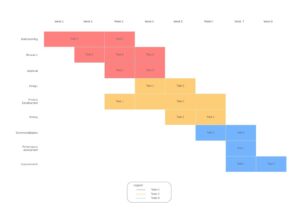
Gnatt chart representing the timetable of the activities planned
You have to create a Gantt chart to represent the activities that are planned for completing this research work within the given time frame. The time frame can change depending on the Univesity’s stipulated guidelines for full-time and part-time Ph.D. programs.
The chart is divided into five different stages, which are:
- Completion of the Course Work: You need to complete the coursework papers as per University Guidelines. This stage is expected to take 12 months.
- Literature review: In this stage, we will review and analyze the existing literature to identify gaps and limitations in the research. This stage is expected to take 06 months.
- Data collection: In this stage, we will collect the required data by conducting experiments and surveys. This stage is expected to take 06 months.
- Data analysis: In this stage, we will analyze the collected data to draw meaningful insights and conclusions. This stage is expected to take 3 months.
- Model development: In this stage, we will develop the proposed model and implement it. This stage is expected to take 12 months.
- Results and Analysis: In this stage, we will gather the results from various dimensions of the proposed model and analyze them. This stage is expected to take 03 months.
- Writing and submission: In this stage, we will write and submit the final research report and the thesis. This stage is expected to take 06 months.
You have to allocate appropriate time for each stage to complete the work on schedule. You have to keep track of the progress regularly and make necessary adjustments to the plan to ensure the timely completion of the research work.
In this section, you have to discuss some potential challenges which you may encounter during your research and how you plan to address them.
Potential Challenges:
- Access to data: Since we are planning to collect data from several sources, it may be challenging to obtain access to all the necessary data.
- Time constraints: We have a strict timeline to follow, and any delays could affect the overall success of the project.
- Technical difficulties: There is always a risk of encountering technical difficulties during data collection or analysis.
Addressing the Challenges:
- Data access: We will communicate with the relevant authorities and request access to the data needed for our research. We will also explore alternative sources of data if necessary.
- Time constraints: We will break down our research into smaller, more manageable tasks and allocate sufficient time for each. We will also build in extra time in case of unexpected delays.
- Technical difficulties: We will test our data collection and analysis tools thoroughly beforehand to minimize the risk of technical difficulties. We will also have contingency plans in place in case of any issues that may arise.
By identifying potential challenges and having a plan in place to address them, you can ensure that your research progresses smoothly and efficiently.
In conclusion, this presentation has outlined a research proposal for a comparative study of deep learning techniques for image recognition in medical imaging. The key points covered in this presentation are:
- The importance of developing accurate and efficient image recognition techniques for medical imaging, which can assist in the diagnosis and treatment of various medical conditions
- A review of the relevant literature in this field has identified the need for further research to compare the performance of different deep-learning techniques for image recognition in medical imaging
- The research problem, objectives, and research question, aim to address this need by comparing the performance of different deep-learning techniques for image recognition in medical imaging
- The study design and methods, which will involve collecting and analyzing medical imaging data using various deep-learning techniques
- The predicted outcomes of the study, which could contribute to improving the accuracy and efficiency of image recognition in medical imaging
- The resources required to complete the study, including access to medical imaging data and computational resources
- The potential societal impact of the study, which could benefit patients and healthcare providers by improving the accuracy and efficiency of medical imaging
- The timetable of activities, which has been represented in a Gantt chart to ensure that the study is completed on schedule
- The potential challenges that may be encountered during the research, and the strategies that will be used to address these challenges.
Overall, this research proposal has the potential to contribute to the field of medical imaging by providing valuable insights into the performance of different deep-learning techniques for image recognition. By improving the accuracy and efficiency of image recognition in medical imaging, this research could ultimately benefit patients and healthcare providers.
Download the PhD Proposal Presentation Template here:
Recent posts.
- Top 10 AI-Based Research Paper Abstract Generators
- EditPad Research Title Generator: Is It Helpful to Create a Title for Your Research?
- Are Postdoctoral Fellowships Taxable? A Guide to Understanding Tax Implications
- How to Get Off-Cycle Research/Academic Internships
- How to End Your Academic/Research Internship?
- All Blog Posts
- Research Career
- Research Conference
- Research Internship
- Research Journal
- Research Tools
- Uncategorized
- Research Conferences
- Research Journals
- Research Grants
- Internships
- Research Internships
- Email Templates
- Conferences
- Blog Partners
- Privacy Policy
Copyright © 2024 Research Voyage
Design by ThemesDNA.com

27 Free Study Plan Templates to Edit, Download, and Print
There might be affiliate links on this page, which means we get a small commission of anything you buy. As an Amazon Associate we earn from qualifying purchases. Please do your own research before making any online purchase.
Looking for a study plan template to improve your academic performance?
Today’s post features a collection of downloadable study plan examples that you can edit and print for personal use. The best part is that they’re all free.
Time management is one of the most challenging aspects of student life. You have your classes to keep track of, and you likely also have extracurricular activities to balance out the academics. You might also have a part-time job. Plus, there’s always your social life to attend to.
A study plan schedule is essential to make sure that you can learn everything in time and master the course material. So if you're not sure HOW this process works, then check out this proven 11-step process to create a study plan that works .
Okay, let's start by talking about the benefits of having a study plan and then we'll dive into the study plan templates you can use.
Table of Contents
The Benefits of Having a Study Plan
Study plans are an effective tool that show you how you spend your time.
You want to make sure that you’re setting aside a sufficient amount of time to study for tests, do your assignments, and complete your projects.
With the rise of online learning, study plans are more important than ever. Using them fosters self-discipline and accountability . It prevents procrastination and helps you develop better study habits , which usually translate to better grades.
To get started, here are three action pads and planner journals that can help you study:
- BestSelf's Weekly Action Pad
- Miliko A4 One Semester Study Planner/Organizer
- PAPERIAN Believe TIME Tracker
And in the following article, you'll find 27 free study plan templates. These work great for students in elementary and middle school, as well as high school and college students, homeschoolers, and those attending online classes.
1. Study Planner with Reading List Template
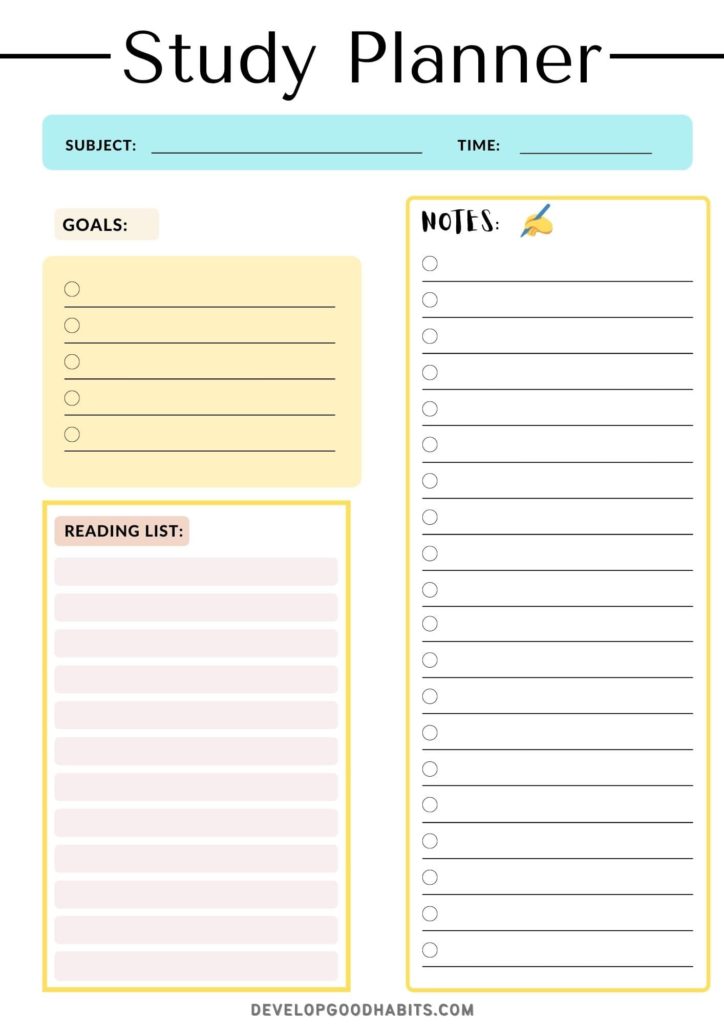
Download the PDF
Are you in for week of intensive academic reading? Our very own Study Planner with Reading List template can help you organize your notes and thoughts and prioritize your schedule so you can stay on top of it all.
Use this template for each one of your subjects to write down your goals and important notes and list down all the materials you need to read so you don’t forget anything. This template comes in A4 size.
2. Study Planner and Schedule Template
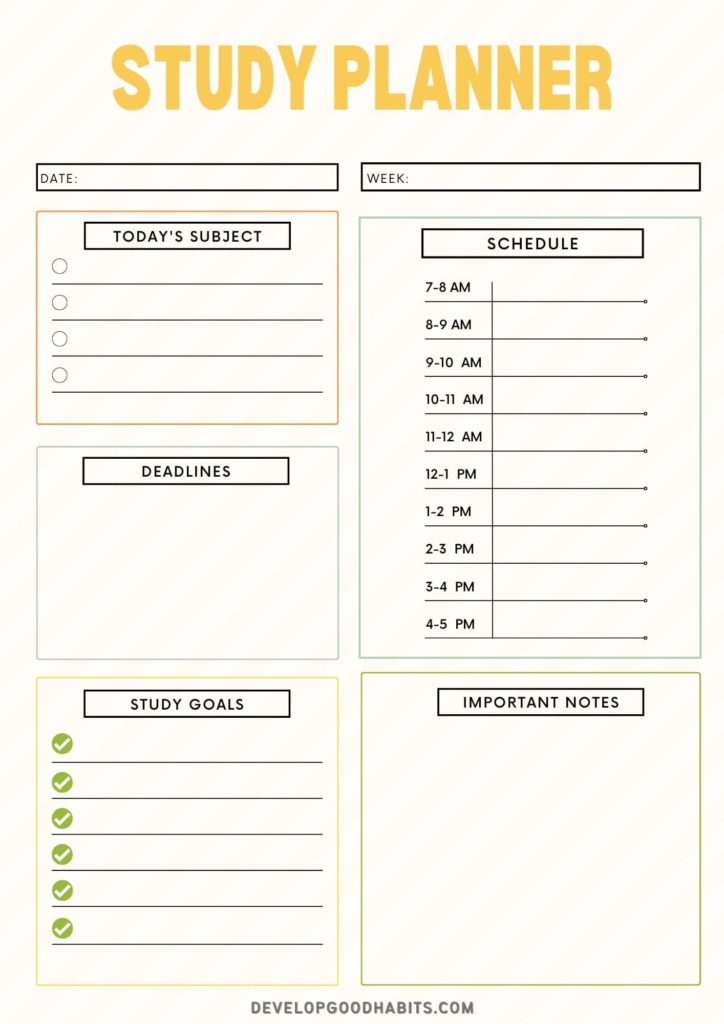
If you’re a student who likes to plan out your day in advance, our Study Planner and Schedule template may come in handy. We’ve dedicated spaces for all of your subjects, an hourly schedule, deadlines, study goals, and important notes so you can see your day’s priorities in a glance. This template comes in A4 size.
3. Unit Study Plan
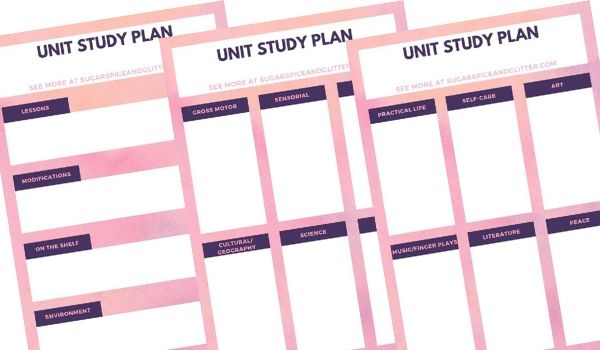
via Sugar, Spice & Glitter
Given the global situation in recent years, homeschooling has become increasingly popular. In many households, parents have become teachers for children who are forced to stay home and shelter in place.
These parents need tools to organize and keep track of lessons. This template works well for homeschoolers as a tracker for unit studies.
This study plan has a Montessori framework , featuring subjects such as:
- Practical life
You can easily modify the titles of the boxes if you’re homeschooling but not using the Montessori model.
4. Black and White Study Planner
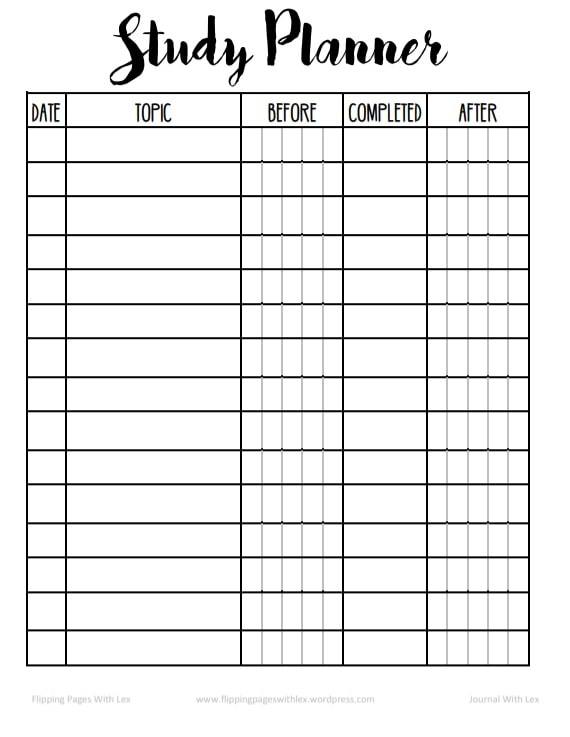
via Flipping Pages With Lex
If you’re looking for a black-and-white themed study planner, you might want to give this sample a try. It has five columns featuring Date, Topic, Before, Completed, and After.
This template can be especially helpful if you’re studying chapters or units. It is also applicable for tracking homework and school projects.
5. Let's Study
This template features a minimalist design with a peach background. It comes with checkboxes, making it easier to keep track of your schoolwork.
The template has spaces allocated for Monday to Friday, as well as for the weekend.
If you’re looking for a straightforward template, the uncluttered look of this one might appeal to you.
6. Study Time Table
This timetable shows your schedule for the entire week on one page. It is helpful in reminding you about appointments, exams, or other important academic events.
It features a seven-day calendar, with time slots from 7:00 am to 10:00 pm.
To further help keep track of your schedule, this timetable comes with icons to specify the categories of your activities. Some of these icons include:
There is also space allocated near the bottom of the page for study notes.
7. Harry Potter-Inspired Daily Productivity Planner
If you’re a Harry Potter fan, this productivity planner might appeal to you.
It features spaces for writing down your tasks, and lets you state how much time you’re allocating for a particular task and what particular subject the schedule is for. There is also a progress tracker for each task so you know how far or near it is to completion.
There are also two boxes on the lower half of the page where you can write down reminders and comments.
What really makes this a Harry Potter-themed planner is the quote found on the lower right-hand side of the page. The words of Professor Severus Snape remind this planner’s user that:
“ The mind is not a book to be opened at will and examined at leisure. Thoughts are not etched on the inside of skulls, to be perused by an invader. The mind is a complex and many-layered thing. ”
8. Blue and Yellow Schedule Printable
This printable planner is designed to help older school-age kids keep track of their schoolwork and develop good study habits.
It has a section where the schedule for the day can be written down, with hourly intervals. This is a great way to introduce kids to time blocking, which is a very helpful tool for productivity and organization.
Space is also designated for writing down daily to-dos, such as homework and chores. There are also spaces for a list of specific goals and notes (e.g., reminders and other important information).
9. Printable Student Planner Pages
If you’re looking for a planner that fits into your binder, this template is worth your attention. It contains all the features you need in order to keep track of assignments, upcoming tests, homework and project deadlines, and school activities.
There is sufficient space to write things down without forcing yourself to use very tiny letters. The planner pages are also undated, giving you flexibility when it comes to organizing your study schedule.
10. Weekly Assignments Printable
Need something to help you prioritize and keep track of assignments from different classes? This printable template is the perfect solution.
To help organize your weekly class assignments, this printable is divided into three major sections.
The first section features sufficient space for listing all your assignments from different classes. This section lets you identify assignments for specific classes and their due dates. If you’re done with an assignment, you can put a mark in the checkbox next to each item.
The template’s second section features a reminder box. Finally, the third section is a mini-calendar with boxes assigned for each day of the week. Here, you can write down important dates so you don’t miss a single deadline.
11. Study Session Planner
Exams coming up? Need a system to help boost your grades this semester?
This planner can help you out with clear-cut guidelines for an effective study routine. It’s full of features that not only enhance your productivity, but also ensure you develop solid study habits that you can use beyond your academic life.
This planner starts off with a checklist of things you need to prepare prior to studying, such as clearing your desk, ensuring that you’ll have minimal distractions, preparing study snacks, and finding music to help you concentrate.
It has space allocated for a list of your tasks, a hydration tracker (because being dehydrated makes it difficult to concentrate), and time management tracking (a Pomodoro ratio and procrastination list). Spaces are also designated to note post-study treats, achievements, and reflections.
12. Today’s Study Session Planner
This template is perfect if you’re looking for a planner to help you focus on studying for a particular subject. It features sections for listing three priorities during the session, topics to study (with checkboxes you can tick once done), and your goals for the day. There are also spaces dedicated for writing notes and indicating the total time studied. Finally, a mini-chart lets you track the number of study breaks taken during a session.
13. Homework Planner Pack
Perhaps you’re getting overwhelmed with the amount of homework and assignments given at school. This homework planner can be used for any grade level to help students organize their schedules, develop good study habits, and meet homework deadlines.
It features ample space where you can list all the upcoming homework, projects, and tests you have for the week, as well as a section where you can indicate due dates and dates of completion. This template comes in three different designs.
14. Pink Study Planner
If you’re looking for a planner that helps monitor your study hours and progress, here’s one that you might want to try. It has a pink theme with spaces assigned for the following:
- Study progress
- Study hours (expected and actual)
- Today’s subject
To get good results in your study goals, make sure to use your planner consistently to organize and remind you about your schoolwork.
15. Study Timetable
A study timetable like this one can be a major lifesaver for students. It helps set routines that save energy and prevent stress when it comes to taking care of schoolwork.
This timetable is in landscape format with a Monday start and has spaces for plotting out your study schedule and other activities from 8:00 am to 10:00 pm.
16. Student Planner Pack
This student planner pack has everything you need to hone your good study habits. The pack contains eight types of study planners that keep you motivated, organized, and productive, whether you’re in high school at university.
These planners can be printed out in A4, A5, or letter size.
Some of the templates you’ll get in the pack include:
- Weekly timetable
- Assignment tracker
- Goal-setting
- Reading list
17. Printable Study Pack
Here is another study plan pack with 10 different planners to help streamline your studies and other academic activities.
The planners are undated for continuous use and feature a simple and elegant design so as not to distract the user from focusing on their studies. The following are included in the pack:
- Daily, weekly, and monthly study planners
- 10-minute planner
- Study plan worksheet
- Study session tracker
- Subject and chapter summary worksheets
- Priority breakdown worksheet
These planners and worksheets are in landscape format and are downloadable in A4 size.
18. College Student Study Planner Printables
College life can be overwhelming. This set of planner printables is designed to give your academic schedule structure that minimizes overwhelm and increases success.
Some of the templates that will help you succeed include:
- Study planner
- Study checklist
- Project planner
- Exam timetable
- Semester overview
- Weekly and monthly calendars
19. The Ultimate College Planner
This set of templates has everything you need to stay on top of your academic life. Designed for college students, this set offers colorful templates and organizers for the following purposes:
- Setting goals
- Organizing class and extracurricular schedules
- Improving study habits
- Keeping track of important dates
Signing up for the newsletter gives you access to this printable planner set.
20. Charlotte Mason Homeschooling Planner
Homeschooling usually has a less rigid schedule than conventional education. However, a homeschooling schedule still needs structure so that homeschoolers can maximize their learning.
This homeschooling planner follows the Charlotte Mason methodology and provides ample space for planning out and organizing an entire year of homeschool.
The planner contains calendars, schedule charts that are especially useful for plotting out a study schedule, weekly spreads, subject notes, and more.
21. Exam Revision Planner
Studying for an exam? Here’s a planner that will help you ace that test.
This planner ensures that you are well-prepared for the exam by letting you break down everything that you need to study into manageable bits.
The PDF template comes in A4 size, which is downloadable in pink, purple, blue, gray, and black & white.
22. Minimalist Unit Study Planner
This template set helps you gain a deeper understanding of a topic/lesson, whether you’re studying or teaching it. It can be used in both homeschooling and conventional education environments to help explore a subject matter from different angles.
23. Semester Study Planner Template
This eight-page planner set is ideal if you’re looking for templates to help you organize your schedule and track your academic progress. It also comes with templates for time management.
The set has a teal color scheme, with features such as:
- Syllabus study planner
- Pomodoro planner
- Checklist for getting organized
- Concept confidence tracker
24. Undated Hourly Five-Day Study Planner
Keep track of your time and manage it well with these planners. You can add in the categories of your choice for your schedule (e.g., work, class, study area, etc.).
A 10-minute planner is found on the bottom half of the page to give you an overview of how you utilize your time each day. The planners come in five different colors, as well as in black & white.
25. Productive Academic Life
This study planner allows you to plot out your schedule for the day and specify the date and the day of the week.
There are spaces for you to write down the following:
26. Editable Student Planning Binder
This planner binder is designed especially for young students. It allows them to have a central place for assignments and other essential documents in class.
Some of the templates included in the 49-page binder are:
- Study goals
- Notes for the week
- Important reminders
- Weekly study planner
27. Daily Study Planner
This daily study planner helps manage daily schedules to maximize your study hours. In addition to the date, you can write your study time goal in hours and minutes, as well as the actual duration of time you spent studying.
It also features space for listing down tasks, with a column alongside each task where you can specify the amount of time (in hours and minutes) you need to complete it.
A time table is also provided, as well as spaces for indicating the subject/chapter/topic/ being studied, study materials, and some notes.
Final Thoughts About Using a Study Plan Template
There you have it—a collection of study plan samples to help you this school year.
So pick one that will best match your needs.
Keep in mind that, in order to reach your academic goals, it’s not just about filling out a student planner. It also involves your commitment to better study habits and embracing a time-management strategy that works for you.
When you have all these, you’ll be set to survive the semester. You may even have a more stellar academic performance.
If you need further resources about study plans and other tools to help in your academic life, check out the following posts:
- The Study Plan Schedule Strategy (That Actually Works!)
- 11 Good Study Habits to Better Understand Your Lessons
- 9 Best Study & Academic Planners for Students
- 14 Best Books on Learning and Building Great Study Habits
- 20 Self-Education Habits to Educate Yourself on Anything
Never stop learning!
Finally, if you want to level up your productivity and time management skills, then watch this free video about the 9 productivity habits you can build at work .

Project Plan Template for PhD
- Great for beginners
- Ready-to-use, fully customizable Subcategory
- Get started in seconds
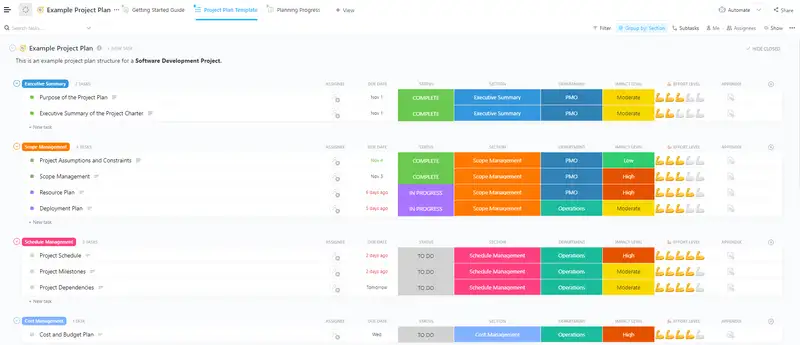
- Organize research activities in an easy-to-follow format
- Provide an overview of coursework, study sessions, and other tasks
- Set achievable goals with clear deadlines for successful completion
Benefits of a PhD Project Plan Template
- Simplified planning and tracking
- Preparation time saved by having all the key information gathered in one place
- Reduced anxiety and stress due to knowing exactly what to expect
- Efficient use of time, since the template freezes the progress of your research
- Helps avoid any nasty surprises along the way
Main Elements of a Project Plan Template for PhD
- Project goals
- Scope of work
- Individual tasks
- Progress reports
How to Use a PhD Project Plan Template
1. brainstorm ideas and goals., 2. establish timeline and milestones., 3. gather resources and tools needed., 4. set up communication channels with team members or mentors/advisers if applicable, 5. create documentation system, 6. track progress periodically, related project plan templates.
- Webinar Project Plan Template
- Email Migration Project Plan Template
- SAP Activate Project Plan Template
- Windows 10 Deployment Project Plan Template
- EHR Implementation Project Plan Template
Related Templates
- Project Plan Template for Outsourcing
- Project Plan Template for Application Migration
- Project Plan Template for EHR Implementation
- Project Plan Template for Real Estate Development
- Project Plan Template for Webinar
Template details
Free forever with 100mb storage.
Free training & 24-hours support
Serious about security & privacy
Highest levels of uptime the last 12 months
- Product Roadmap
- Affiliate & Referrals
- On-Demand Demo
- Integrations
- Consultants
- Gantt Chart
- Native Time Tracking
- Automations
- Kanban Board
- vs Airtable
- vs Basecamp
- vs MS Project
- vs Smartsheet
- Software Team Hub
- PM Software Guide
• Non-Chinese citizen with a valid passport.
• Ph.D program applicants should have a Master's degree or an equivalent degree to a Master's degree (or above) in China.
• HSK Level 5 over 210 or HSK Level 6 over 180 is required, and priority is given to applicants with higher level of proficiency in Chinese under same conditions.
Tuition, living expenses and research allowances, international traveling expenses, etc.
Feb. 28, 2024
The applicant shall submit the online application at both Scholarship website: http://www.chinese.cn/page/#/pcpage/csp and ECNU website: http://lxsapply.ecnu.edu.cn/. Please Upload application documents and pay the 800 RMB application fee online, which won't be refunded no matter admitted or not.
• Notarized transcripts of undergraduate and master's studies, degree certificates and a Chinese translation for each
• Recommendation letters in Chinese or English from two experts in the field, including professors or associate professors
The issue date of the recommendation letter should be later than September 1st, 2022.
Recommendation letter MUST include: the designation, working place, contact telephone, email and the signature of the recommender.
• HSK transcript (HSK Level 5 over 210 or HSK Level 6 over 180)
• Doctoral study plan.
• Catalogue and abstract of published papers, or other documents that proves academic ability; the abstract of your Master degree thesis instead of the full text.
• Photocopy of Passport (Include personal information page and Chinese visa pages if you have been in China)
• Non-criminal certificate (notarized photocopy in Chinese or in English)
1. Applicants must ensure that the application information and application materials provided are true and accurate. If any application documents are verified to be not true, the application, admission or study qualification will be cancelled.
2. Once admitted, applicants cannot be registered at two universities at the same time (except for double degree programs). Once found, the study qualification will be cancelled.
3. Applicants should actively pay close attention to the latest relevant information posted at the website or sent by the school/department applying to. Applicants must read and follow the posted instructions/deadlines timely, and any consequences for failing to do so will be the responsibility of the applicant solely.
Global Education Center of ECNU
Add: Room 253 International Students Office, Physics Building, 3663 Zhongshan North Road, East China Normal University, Shanghai.
Tel: +86-21-62232013 +86-21-62238353
Email: [email protected]
China Studies Program Major Lists

COMMENTS
A PDF document that outlines the requirements and steps for completing a PhD in Communication and Film at the University of Memphis. It includes sections for research agenda, exam areas, coursework, and committee information.
Learn how to create a GANTT chart for your PhD research plan, a graphical representation of your goals and objectives with time duration. Find out the common objectives, tips and custom writing services for PhD research.
Example: Planning year 2 of a 3-year PhD. Maria completed her first round of data collection according to plan, and starts the second year of her PhD with a lot of material. In her second year, she will focus on turning this data into two journal articles. Months 1-2: Maria works on her data analysis.
Learn how to prepare a research plan for your PhD with steps, goals, problems, solutions and timeline. Download a ready-to-use template and see examples of research plans.
Create Your Plan. To be successful both in graduate school and beyond, it is important to: define your priorities; identify resources and areas of development; develop goals and a timeline; follow through with your plan; reflect on your achievements and growth; and reevaluate your plan periodically to make adjustments as your interests, skills, and goals evolve.
Sample PhD Study Plans. This appendix contains sample PhD study plans for students wanting to focus in one of the following areas: Students who pass one or both of the preliminary exams before the start of their first fall semester can skip the corresponding Master's core courses, and follow the plans for Year 2 and on.
Doctoral Plan. 1. 5. Detailed Work Plan. Describe the studies or experiments envisaged to reach the set goals. Present your work plan in the form of work packages (WP), each defining the task and describing the methods used and the expected outcome. In general, a work package should describe 3 -. 12 months of work.
Project description. The description should be one to three pages, written by the PhD student and approved by the supervisor. The description may be included in the form, or attached as an appendix. Start with an introduction describing the project in a broader context. Give the background and motivation for the topic of the PhD project.
Therefore, in a good research proposal you will need to demonstrate two main things: 1. that you are capable of independent critical thinking and analysis. 2. that you are capable of communicating your ideas clearly. Applying for a PhD is like applying for a job, you are not applying for a taught programme.
Research plan of up to 5 pages, including a description of the objectives and research questions, state of knowledge and finally an evaluation of the qualification of the applicant to conduct the planned research. Please use the format below. (Note that the bibliography is not included in this part.) 2. Study plan (1-2 pages). 3. Financial plan.
Computer Science Plan of Study Templates. 2023-2024. Computer Science PhD Template ... 2022-2023. Computer Science PhD Template Computer Science MS Non-Thesis Template Computer Science MS Thesis Template Digital Forensics MS Non-Thesis Template Digital Forensics MS Thesis Template
A Template To Help You Structure Your PhD's Theoretical Framework Chapter. In this guide, I explain how to use the theory framework template. The focus is on the practical things to consider when you're working with the template and how you can give your theory framework the rockstar treatment. Use our free tools, guides and templates to ...
How I Made My PhD Completion Plan on Excel (With Template) For the last few weeks, I've been working on my PhD completion plan. It's basically an excel spreadsheet that I'm using to track my progress and plan my time for the remainder of my PhD. My thesis is due August of next year (with a 6 month extension) so the clock is definitely ticking.
It is a less. structured parallel to the Time Schedule that fo llows later. Phase 1: Get full and in depth understanding of the theoretical framework outlined in this study plan and the MC ...
A doctoral study plan template for the School of Engineering and Natural Sciences at the University of Iceland. A repo for issues and updates is here: htt... An online LaTeX editor that's easy to use.
A successful PhD journey begins with a solid plan that includes a PhD timeline. A thought-through and well-designed PhD timeline requires some time but can be accomplished in a few simple steps. Contents Why a clear PhD research timeline mattersStep 1: Decide what to include in your PhD timelineStep 2: Discuss your provisional PhD timeline
1. Wrap up your study plan with a short summary. At the end of the plan, reiterate why you want to study at your chosen program, and repeat why it is important for meeting your goals. Also, add a few words about how the scholarship can help you achieve your goals.
This template can be used by Ph.D. candidates from various fields who are preparing for their Ph.D. registration. Slide 1: Title Slide. Title of the work. Candidate's name and affiliation. Supervisor's name and affiliation. Slide 2: Introduction. Briefly introduce the topic. Explain why the topic is important and relevant.
And in the following article, you'll find 27 free study plan templates. These work great for students in elementary and middle school, as well as high school and college students, homeschoolers, and those attending online classes. 1. Study Planner with Reading List Template. Download the PDF.
A comprehensive research proposal is one of the most important parts of your PhD application, as it explains what you plan to research, what your aims and objectives are, and how you plan to meet those objectives. Below you will find a research proposal template you can use to write your own PhD proposal, along with examples of specific sections.
Purpose of the PhD research plan • Develop a PhD project with realistic goals that can be achieved within the timeframe of the PhD period (normally 3-4 years). • Ensure that the PhD student and PhD supervisor(s) are aligned wrt goals of the project and the work plan/schedule. • Critically evaluate the overall objectives.
Our PhD project plan template gives you the tools to create a detailed roadmap that covers everything from research activities to coursework and milestones. The PhD project plan template helps you: Organize research activities in an easy-to-follow format. Provide an overview of coursework, study sessions, and other tasks.
Contact us. Global Education Center of ECNU. Add: Room 253 International Students Office, Physics Building, 3663 Zhongshan North Road, East China Normal University, Shanghai. Tel: +86-21-62232013 +86-21-62238353. Email: [email protected].